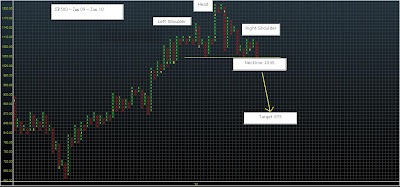With regard to the EURUSD I have talked to a few people who are frustrated with the failure of EURUSD to decline alongside US share indices this past week. This leads me to question whether the correlation between the two is breaking down. Below is a set of charts showing the SP500 over the past 5 years together with the EURUSD , and below them a chart of the 60 day correlation during that time. My reading of this (and I am no stato, so it is really a rather amateur reading), is that the correlation is generally rather poor, veering between periods of high correlation and low correlation but with no real consistency.
 Further to this I have looked at the 60 Week correlation going back to 1990. And this shows an even less consistent relationship, and if anything the periods of high correlation have tended to occur at times of Equity and EURUSD strength.
Further to this I have looked at the 60 Week correlation going back to 1990. And this shows an even less consistent relationship, and if anything the periods of high correlation have tended to occur at times of Equity and EURUSD strength. So with no real evidence of a link between US equity index performance and the EURUSD historically, why the obsession with looking for weaker EURUSD when US equities moving lower? I have a view as to why this might be, it may be right or it may be utter nonsense, but here goes anyway: The 2008 sell-off in Equities and EURUSD was a complete flight from all risk, and since both Long Equities and Long EURUSD were long-held risk trades at the time, their correlated move was not surprising. The recent move lower in stocks at the end of April, was in part triggered by fears of a full-blown Euro Sovereign Debt crisis, this itself was causing a flight from the EURUSD.
So with no real evidence of a link between US equity index performance and the EURUSD historically, why the obsession with looking for weaker EURUSD when US equities moving lower? I have a view as to why this might be, it may be right or it may be utter nonsense, but here goes anyway: The 2008 sell-off in Equities and EURUSD was a complete flight from all risk, and since both Long Equities and Long EURUSD were long-held risk trades at the time, their correlated move was not surprising. The recent move lower in stocks at the end of April, was in part triggered by fears of a full-blown Euro Sovereign Debt crisis, this itself was causing a flight from the EURUSD. However over the past couple of weeks, I believe it is has been different. The weakness in equity markets is probably due to fears of poor US economic prospects (Double dip recession), not as a result of a Bank/HF deleveraging and consequential risk flight, nor as a result of a heightening of the Euro Sovereign Debt crisis. Therefore since the reason for this move would be a re-evaluation of US economic prospects, that should not be supportive for the USD going forward. On the other hand EURO economic prospects have already been massively downgraded as a result of the Euro Sovereign Debt crisis. -- Also, since an equity sell-off is leading to flight from risk (though not on the scale of 2008) it could be argued that this may actually be supportive for the EURUSD, since in 2007/8 risk was long EURUSD, whereas now I would guess risk is short EURUSD.
Shorter-term a break (and hold) through the 40 day moving average @ 1.2323 will be supportive for the EURUSD, and a break and hold over 1.2400 would confirm an inverse Head & Shoulders pattern, which could potentially see a move towards 1.3000. - On the other hand a successful break of the mid 1.2100 area, could spark a re-test of the lows of early June. --- Saying all that, the EURUSD has limited upside in the bigger picture due to its on-going concerns which are likely to continue to weigh on it, and I believe will eventually lead to sub-par levels over the next year or two.

















































.png)


.png)